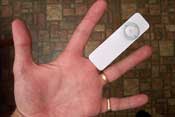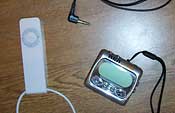Do I have one of the first iPod shuffles in Canada?
Permalinks to this entry: individual page or in monthly context. For more material from my journal, visit my home page or the archive.
UPDATE: To answer the title's question, a couple of my readers tell me that no, I don't. And even saying that it's one of the first in Vancouver is dead wrong, since apparently Mac Station has been selling them for a couple of weeks, though they remain in short supply. So all I can say confidently is that the ones we received at work were the first ones I'd seen.
 I can't confirm the claim, but yesterday the employees at my work apparently became the owners of the first shipment of Apple's iPod shuffle players in Canada. They are almost certainly the first shipped to Vancouver. (My company's founders kindly gave each of us a 512 MB one to celebrate a good year.)
I can't confirm the claim, but yesterday the employees at my work apparently became the owners of the first shipment of Apple's iPod shuffle players in Canada. They are almost certainly the first shipped to Vancouver. (My company's founders kindly gave each of us a 512 MB one to celebrate a good year.)
So now I'm part of the tribe. My first impression was not about how small it is (plenty of MP3 players are small), but how light. When it's in a pocket or bag or around your neck, you just don't notice it's there (which will, I'm sure, lead to many people losing their iPod shuffles, or having them stolen, and not finding out till much later). It is, I expect, the lightest way to carry around 120–150 songs that has ever existed.
Like James Lileks, I've found the iPod shuffle experience educational:
...when you have 10,000 songs you are always compelled to see what's next, whether it's better than this. When you have 100 songs, and A) have no idea what comes next and B) haven't heard 60 of them in a long long time, if ever, you tend to listen.
The lack of a screen is fine in most circumstances, if you're just listening as you would to the radio or a CD changer. But it can be a pain if you're trying to find a specific track, or move on to the next album in a set, or simply figure out what that song you never knew you had is called when you're away from the computer. Still, it prods you to enjoy the music rather than analyze it.
What's most striking, after you've used it a bit, is the iPod shuffle's minimalism. Apple obviously spent considerable time and effort figuring out what to take away, rather than what to add, and how to make the remaining stripped-down essentials as easy and basic as possible. Here is everything you can do with it when it's not plugged into a computer:
- Turn it off.
- Switch it to regular play.
- Switch it to shuffle play.
- Check the battery status.
- Plug or unplug headphones (or another audio line for the 1/8" jack).
- Start music playing.
- Pause music playing.
- Lock the front-panel controls (so they don't press accidentally), or unlock them.
- Go back the beginning of the list of tracks.
- Skip to the next track.
- Start the track over, or skip to the previous one.
- Fast forward or rewind (in choppy increments).
- Raise or lower the volume.
- Remove the end cap, to pop on the lanyard cap, or to plug the iPod in.
I don't think I missed anything. And neither did Apple.
 But that last task is the key. Besides the shuffle's appearance and good sound, its ability to plug in and synchronize with iTunes is what makes it an iPod. That's regardless of whether you buy songs from Apple's store, which I don't, or just use files ripped from your album collection, or those you make with GarageBand, or whatever. Much of the intelligence and power of the iPod brand—more than I realized, especially for this model—comes from that piece of software. Little touches make a huge difference, like the ability to transcode tracks to good-quality 128 kbps AAC files if they are stored at a higher, larger-file-size bitrate—or in an incompatible format—on your computer.
But that last task is the key. Besides the shuffle's appearance and good sound, its ability to plug in and synchronize with iTunes is what makes it an iPod. That's regardless of whether you buy songs from Apple's store, which I don't, or just use files ripped from your album collection, or those you make with GarageBand, or whatever. Much of the intelligence and power of the iPod brand—more than I realized, especially for this model—comes from that piece of software. Little touches make a huge difference, like the ability to transcode tracks to good-quality 128 kbps AAC files if they are stored at a higher, larger-file-size bitrate—or in an incompatible format—on your computer.
My previous MP3 player is nearly as small, and almost as light, and it has a screen (see photo). But it is profoundly inferior: it doesn't work seamlessly with iTunes, its interface and appearance are clunky, it has been a bit flaky since I first got it, and over time firmware upgrades have actually worsened its performance, even degrading the sound quality significantly. Plus it holds many fewer songs, and was more expensive. I speculated that Apple would own the entire MP3 player market after the shuffle was introduced. Now that I own one, I'm sure of it.
TIP: If you use the Autofill feature of iTunes with an iPod shuffle, set it to pick from a Smart Playlist that excludes stuff you don't want to take along. My "Mostly Rock" list, for example, is set so that it contains only songs where the Genre does not include terms such as Christmas, Spoken Word, Children's, Holiday, and Sound Effects, among others. Here are some more tips.
Now, I was faced with a decision: use the distinctive white earbuds, or not? For me, the choice was easy, since I prefer my Sony behind-the-neck headphones, for comfort, convenience, and sound—I've never liked earbuds for a variety of reasons. But I was tempted, because unlike some people, I kind of want people to know I have an iPod. I've rarely been swayed by fashion over convenience, but I nearly was in this case.







